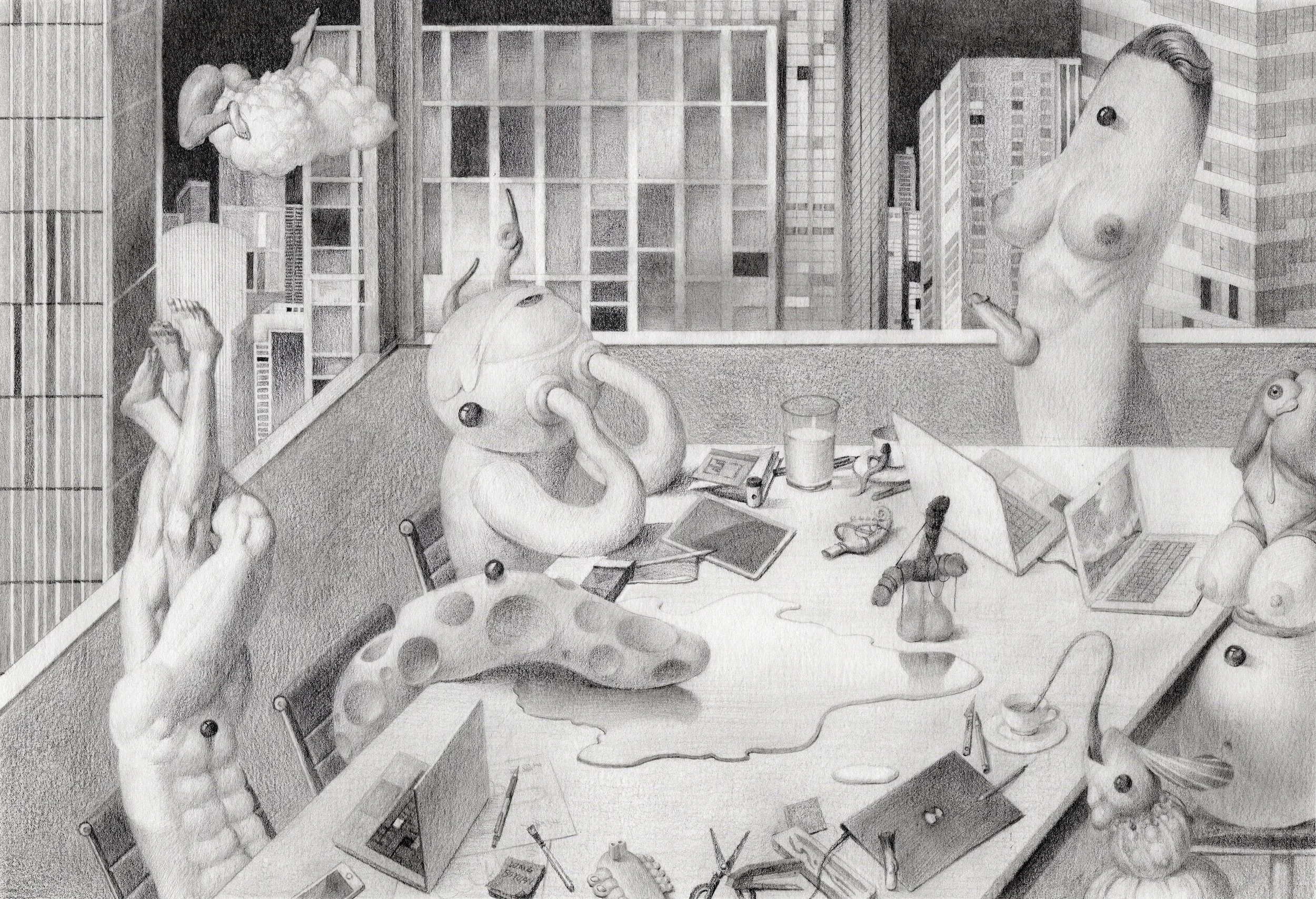10 Questions with Meicheng Chi
Al-Tiba9 Art Magazine ISSUE17 | Featured Artist
Meicheng Chi 迟美橙 is a multidisciplinary artist and designer currently based in New York. With a BFA in Industrial Design and a Concentration in Drawing from the Rhode Island School of Design (RISD) in 2022, she seamlessly bridges the realms of fine art, illustration, and fashion accessories design. Her creative practice transcends conventional boundaries, allowing her to explore emotional and material connections across different mediums. Meicheng’s work has been exhibited in prestigious galleries across China, the U.S., and Europe, garnering international attention. In 2023, her drawing series ‘Sleep Talking’ was archived by the Museum of Avant-garde, a significant recognition of her evolving artistic voice. Her artistic journey centers on the intuitive act of drawing, which she views as the purest form of emotional expression. Through her artworks, Meicheng taps into deeply personal experiences and dreamlike states, creating pieces that resonate with softness and emotional depth, inviting viewers to share her introspective narratives.
Meicheng Chi - Portrait | photo: Yukai Chen
ARTIST STATEMENT
For Meicheng Chi, drawing acts as a dialogue between consciousness and the subconscious—like the ephemeral nature of sleep talking, where half-remembered dreams linger in vivid detail. Her work is defined by the fluidity of lines, abstract forms, and the incorporation of surreal elements that invoke a sense of nostalgia and emotional resonance. The recurring themes in her drawings echo the gentle freshness of natural landscapes, as if they carry the delicate scent of grass, creating a poetic link between memory and the present. Through this visual language, Meicheng’s practice becomes a way of transforming negative emotions into tangible forms. Her lines, strokes, and colors hold space for vulnerability, turning raw emotion into something that can be held, understood, and shared with others. Each piece is an invitation to embrace the intangible, offering comfort and connection through the soft, dreamlike imagery that emerges from her introspective creative process.
Ceramic Chairs, 2024 © Meicheng Chi
AL-TIBA9 ART MAGAZINE ISSUE17
INTERVIEW
First of all, what inspired you to pursue an art career? What initially sparked your passion, and what continues to drive your creativity today?
My artistic journey started when I was 3 years old, drawing on everything I could find at home—paper, books, even walls. Growing up in a creative environment with parents who are both designers and artists, I was encouraged to draw freely, without boundaries or restrictions. I kept exploring various media and tools, seeking spaces where I could experiment and express myself authentically. Coming to the US to explore the world of art and design, I was exposed to various media and tools, and had access to workrooms where I could get dirty, messy, and experiment freely. Drawing has become a personal retreat for me, where I navigate and connect with my emotions in the most genuine way. I always draw or paint during my leisure time besides work, allowing myself precious personal time to be unreasonable, connect with my inner self, and express my ideas to others. Outside of work, I collaborated with artists, designers, and brands on diverse projects, including music album covers, visual presentations, and advertisement animations. Each project energizes my creativity and offers new, exciting opportunities for expression with creative sparkles.
She Grew, 2024 © Meicheng Chi
Looking back, is there something you wish you had known about the contemporary art world before embarking on your artistic journey? Were there particular challenges, opportunities, or realities that surprised you, and how did you adapt to them?
Looking back, I wish I had understood earlier the importance of connecting with people and actively introducing myself to a broader audience. Early in my journey, I focused more on creating my work and refining my vision and process. While that was valuable, I've come to realize that building relationships and sharing my story is just as important as the art itself. Adapting to this challenge meant stepping outside of my comfort zone. I started engaging with more communities and reaching out to other creatives whose work I admire. These experiences helped me build confidence in sharing my voice and forming meaningful connections. Over time, I've found that opening up to others has enriched not just my opportunities but also my perspective and approach to creating.
Drawing seems central to your work. Can you describe what the process of drawing means to you and how it helps you convey your ideas?
For me, drawing has always been an intuitive and expressive language, much like speaking. It allows me to convey emotions and thoughts that words often cannot capture. With sharpened coloured pencils, a clean desk, and the mood to draw, I start to transfer my emotions, memories, and images from my subconscious onto the paper. I would draw rooms I want to remember, things I'm afraid to lose, people that I want to meet, a feeling I'm having at the moment, or just boringmundane things. I want to remember the feelings and emotions that burst out when I encounter or touch these things, or the people, under a certain temperature, in that colour of light and in those places with those textures and transfer all these onto paper. I primarily work with coloured pencils, drawn to the textures I can create with coloured pencils using different strengths and different speeds, each telling a different story. I love the saturated colour, the soft and sharp lines created by the media, and even the little gaps between each stroke.
Back to School, 2021 © Meicheng Chi
Tiger in a wet dream, 2023 © Meicheng Chi
Grass Store, 2021 © Meicheng Chi
Water Pond, 2021 © Meicheng Chi
Your work reflects themes of subconscious thought and dream states. What inspires you to delve into these realms, and how do they influence your creative flow?
I first began working with coloured pencils to capture memories from dream states after dreaming about my great-grandfather's house. In the dream, I stood in his kitchen and watched a few birds fly by. When I turned back, they had transformed into flat patterns on the window. Though I was half-awake, the images felt vivid, tender, and deeply touching. I wanted to preserve the lines, colours, and emotional intensity of that moment. Since then, drawing has felt like sleep-talking, a way to express half-awakened memories in their most vivid form. Creating allows me to transform the romantic imagery of my unconscious mind and faded memories into new, unknown images and stories or to let those images surface into my consciousness. I fold and unfold my memories, cherishing each crease as if it were a moment from my life or a fragment of my imagination—embracing and preserving every delicate line.
Your drawings are often described as soft and emotionally resonant. How do you translate personal experiences and emotions into your visual language?
Drawing is a poetic preservation of my emotional experiences, feelings, vulnerability, memories, and experiences, and Iallow them to shape my work organically. The images in my mind naturally flow into pencil strokes—tangible forms I can hold, cherish, and keep. I always work in the delicate space between words and images, where poems and diaries I write often spark scenes or visions, and intuitive drawings, in turn, inspire words to surface. Guided by whatever stirs within my heart and mind, I create art that reflects my true self — a fusion of emotions, thoughts, and fleeting moments transformed into something lasting, inspiring others to connect with a tender part of their inner world.
Natural landscapes and nostalgic elements frequently appear in your work. What role does nature play in your practice, and how does it relate to memory and emotional expression?
Nature plays a central role in my drawings, expressing feelings, memories and emotions in subtle, poetic ways. I want my work to feel as if it has been touched by a gentle breeze, carrying the fresh scent of grass, evoking a poetic connection between the emotions I have in the moment and memories from the past. The changing seasons heighten mood swings and create a sense of warmth and closeness between people. Falling in love, for me, feels like slowly sinking into the embrace of summer or running across a soft, long grassland for years. These natural elements bridge the tenderness of the present with the echoes of the past.
Ceramic Chairs, 2024 © Meicheng Chi
Ceramic Chairs, 2024 © Meicheng Chi
Your work has gained recognition in multiple countries and prestigious galleries. How has the international response to your art influenced your practice?
For me, drawing is like talking—there are no boundaries to art as a language. This makes it incredibly powerful and meaningful, especially when shared with an international audience. I love letting my 'sleep talking' be heard by a wider group, and it deeply moves me when people from different countries send me photos of my drawings displayed in their personal spaces. The more people I reach, the more surprises and inspiration I find. One person even reached out on Instagram, asking if they could tattoo the chairs I drew. It's incredibly touching to create personal connections with people I've never met, knowing they want to keep my art on their body and carry it with them.
The 'Sleep Talking' series was recently archived by the Museum of Avant-garde. How does this recognition shape your perspective on your evolving artistic voice?
Having my work recognized by the Museum of Avant-Garde is an exciting milestone. I create from a place of genuine expression, and this recognition reinforces the power of staying true to my perspective. Moments like this remind me that staying true to myself does make art resonate, inspiring me to keep pushing my ideas further—to explore, experiment, and let my work evolve naturally. It's not just about reaching a bigger stage but about deepening my connection with art and the people who experience it.
Happy New Year, 2021 © Meicheng Chi
Are there any new projects or themes you're currently exploring? What direction do you see your work taking in the near future?
Lately, I've been drawn to ceramics as a new way to bring my art to life. Shaping my drawings into functional objects and sculptures feels intimate—like giving form to something that once only existed in my mind or only on paper. When fired in the kiln, these pieces become solid yet still hold the softness of their beginnings. I love how lines and textures translate into something tangible, something that can be held and used. More and more, I see my work weaving into daily life—as objects, furniture, even things to wear—finding new ways to connect with people through touch, form, and pencil strokes.
As an artist whose work bridges different disciplines, are there any new media or collaborative fields you'd like to explore in your upcoming projects?
I've always been drawn to the idea of collaborating with musicians, as their work ignites my creativity in unique and powerful ways. Music has a way of evoking emotions and vivid imagery that I love translating into visual art, whether through album covers, music videos, or other projects that capture the essence of a song or an artist's identity. I'm also fascinated by the idea of working with furniture designers to bring surreal scenes and imaginative objects from my drawings to life on a larger scale or even create a space. Coming from an Industrial Design background and having once been a furniture designer myself, I love the idea of blending art with the tangible world in new and unexpected ways. Whether it's creating sculptural furniture or immersive spaces, these collaborations would let me expand my artistic language and share my vision in exciting ways.



























